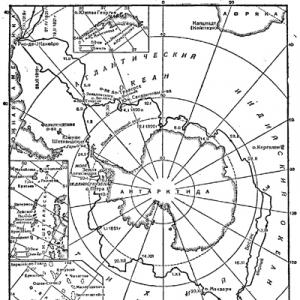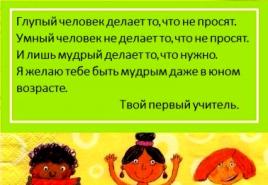How to translate sentences in English. How to translate English texts correctly, or How to translate thoughts into words
Every person who studies a foreign language, one way or another, is faced with the need for translation. Students learn to translate read or listened to texts, English books and dialogues from a foreign language, as well as translate simple sentences and, most importantly, their thoughts from their native language into a foreign language. So what is translation and what is its meaning? Let "s see ...
Talking about translation, many linguists distinguish between two concepts: translation, as the process of transmitting an oral or written text in one language by an equivalent text in another language, and translation, as a result of this process, that is, the written or oral text itself, conveying the same meaning or having the same content in another language. Thus, in essence, translation is a search for corresponding equivalents in another language, allowing one or another meaning to be conveyed.
For a long time, translation has been the main means of exchange of information and knowledge about the world. In the 21st century - the century of information - it is difficult to imagine a field of activity in which one or another type of translation would not be applied. In the modern world, international borders in business, science and other industries are erased, therefore translation is becoming more necessary than ever as the basis for understanding and fruitful cooperation.
How to translate correctly from English
Translation from English into Russian, due to the use of the former as an international one, is more relevant than ever.
There are several types of translation: literal, automatic or machine translation, as well as professional.
Talking about the latter. The first step is always working on the text and its structure, as well as carefully reading the source material. After that, work takes place on the words that require special attention. Next, a so-called translation sketch is performed with the designation of doubtful places in the text, which need to be worked on in the future. You may think that this kind of work is beyond your strength, but this is how a high-quality translation should be done. Deal with it.
Literal and machine translations are the least effective and can be used to understand the general meaning of the translated text.
Some tips:
- use modern dictionaries and do not forget about the existence of electronic ones, for example multitran.ru, which contains vocabulary, as well as sayings, idioms and phrases that are used in professional fields;
- do not try to translate all unknown words, try to understand the essence of the text;
- pay attention to the different possible variants of one word (word morphs), remember also that there is a participle and a gerund;
- look at the endings of the verbs: this will help you not only to understand the tense of what is happening, but also to determine the character;
- be aware of language exceptions (swim - swam or die - dying), as well as phrasal verbs (put away, put across, put on, put down);
- do not forget that one word can be both a noun and a verb at the same time, for example, drin, answer, sleep, cook, shade, climb, cook, etc.
Online translation services
Various online services are widely used for the above types of transfers. The most famous and frequently used translation service at the moment is the online translator from English to Russian - Google translate. Its distinctive feature is the presence of a large number of supported languages - 103, as well as the ability to automatically translate web pages and large texts. However, the main disadvantage of this service is not always the correct choice of vocabulary and incorrect construction of sentences. An excellent option for understanding the general meaning, but not comparable to a professional translation.
How to translate from English into Russian, you can use online dictionaries that contain a large number of word meanings, transcription, several pronunciation options, as well as examples of use in authentic texts. Noteworthy is the online translator Lingvo Live from ABBYY. It has fewer languages - 20, and is capable of translating individual words and phrases. Nevertheless, the translation is presented in various headings: medicine, jurisprudence, etc., as well as with many examples from the original texts. I am also glad to have the opportunity to ask translators for help absolutely free of charge if the translation was not found.
You can also translate from English into Russian using the translate.ru (prompt) service from Runet. A small number of languages - 7, and the ability to translate large texts. It differs in the function of choosing the subject of the translated text, for example, travel, sports, health, which narrows the choice of the necessary vocabulary.
Professional translation
Professional translation from English is distinguished by its accuracy and complete transfer of the meaning and form of the translated text. So, if, for example, the original test is of a technical nature, then embellishment of the test is unacceptable - the accuracy of terms and the use of stamps and cliches are important.
direct current- direct current
sectional area- cross-sectional area
If the source text is a dialogue on an everyday topic, the main task of the translator is to find the most natural version for translation.
Here you are!- Here you go!
Help yourself.- Help yourself.
If the source text is a literary text, then it is important to use synonyms, change the order of words, as well as figures of speech: epithets, metaphors, hyperbole.
sharp eyes- piercing look
I'll move heaven and earth to reach it.- I will move mountains to achieve this.
Lost in translation
Setting the goal to translate from English, each translator faces some difficulties caused by both the peculiarities of the English language and the specifics of the target one.
Lexical difficulties
Most words in English are ambiguous. Thus, the main lexical difficulty of translation is the choice of the desired and most appropriate meaning. For example, the verb run can be used to mean "to run" and to mean "to manage": so run a marathon - to run a marathon, run a restaurant - to run a restaurant. In addition, it also translates as "work", in terms of "function": Is your refrigerator running? - Is your refrigerator working?
Also, an important point in translation is the definition of the part of speech that the word is represented by. Quite a lot of words in the English language have the same form in different parts of speech, therefore, how to translate a word from English into Russian directly depends on the part of speech that it is represented by.
I read an interesting book (noun).- I am reading an interesting book
I called to book (verb) a table.- I called to get the table.
He's like (adverb) me... - He's the same as me.
He likes (verb) me.- He likes me.
Some difficulties also arise with how to translate the well-known false friends of translators - words that are similar in form to existing words in the target language, but differ from them in meaning.
baptism- baptism, not baptism (Baptist faith)
expertise- experience, competence, knowledge, but not expertise (expert examination)
intelligent- reasonable, quick-witted, but not intelligent (cultured)
clay- clay, but not glue
When translating, it is necessary not to forget about the compatibility of words, especially the verb + noun in English: take a photo - take pictures, have a party - throw a party, and the adjective + noun in Russian: brown eyes - brown eyes, gray hair - gray hair.
Grammatical difficulties
The grammatical structure of the English and Russian languages is significantly different. An important point in translation is the choice of the most appropriate time, or words indicating the required time. So, the Present Perfect, depending on the context, can be translated using the present or the past tense:
I have already been there.- I've already been here.
I have been in Paris since Monday.- I've been in Paris since Monday.
Another interesting point is related to the use of pronouns. In English, there is a clear sentence structure - subject and predicate. Therefore, most sentences are built using the pronouns it, they, we, you. In the Russian language, there is a tendency to use impersonal forms of the verb, or the pronouns are simply omitted.
They say he is a good man.- They say he is a good man.
It rains.- It's raining.
An important aspect is the translation of the passive voice, which is quite often used in English and has several translation options:
- Using the verb to be:
This text was written on the blackboard.- The text was written on the board. - With the help of reflexive verbs ending in -ся / -с:
The window was suddenly opened.- The window opened unexpectedly. - Using 3rd person plural active verbs:
The books are given on the first floor.- Books are given out on the first floor.
Conclusion
From all of the above, it follows that translation is not an easy job, affecting many aspects of language learning, the correct choice of vocabulary, knowledge of the many meanings of words and their compatibility with other words in a sentence. Also important is the knowledge of all grammatical formulas and rules of grammatical construction of sentences.
It should also be noted the importance of knowledge of English punctuation and spelling for translation. Like any skill, fast and accurate translation needs constant practice and improvement. But patience and work will grind everything!
We wish you good luck!
Big and friendly family EnglishDom
Learning the basics of translation
Most modern techniques do not include translation exercises. Basically, all the tasks today are aimed at the development of colloquial speech, and not at how to translate into English. This is a very rational approach to learning a foreign language. Nevertheless, the good old text translation tasks have their undeniable advantages. It is especially important to be engaged in translation for those who plan to link their professional activities with English in the future.
In this article, we propose to see what benefits can be obtained from translating texts from one language to another, and how to translate them correctly.
Translation exercise options
- Find a good textbook
Find a quality manual in English in Russian. As a rule, such teaching materials are filled with different exercises for translation from Russian into English and vice versa. In such textbooks, tasks, for the most part, are provided for practicing various grammatical structures, and by practicing regularly, you can bring the use of most of them to automatism. You can find the textbook in paper form, or you can search for exercises online. - Interpretation and translation
Practice both interpretation and writing. Both exercises have their benefits. So, translating the text orally, you can practice your pronunciation and immediately practice speaking. While in translation, you will practice your spelling. - Translate under dictation
We recommend that you try to do simultaneous translation. Ask someone to dictate the text to you in Russian, and immediately write down the English version of this text yourself. Such classes will allow you to learn how to find speech matches as quickly as possible, develop the speed of thinking, and also allow you to practice using the learned vocabulary and grammar. Thus, you will contribute to the withdrawal of words from the passive vocabulary into the active one, making it easier to remember them during communication. - Read and translate
Find an article in English on the Internet that matches your level of knowledge. Try to translate it. Remember that when translating, the most important thing is to convey the meaning of what the author has said, therefore, if the text contains about 10% of unfamiliar vocabulary, do not rush to translate it, just try to understand the meaning of unfamiliar words from the context. It will be great if this article is already in a professional translation. Thus, you can compare your creation with her and check how well you feel in English. - From Russian to English
Find a simple text in Russian and try to translate it into English. Children's stories or articles with simple vocabulary are ideal for this exercise. Write down your version of the translation, and after a while check it for errors. You can ask a friend who is fluent in English or a teacher to check your text and compare it with the translation. Also, if among your friends there is a person who, like you, studies English, you can offer him to translate the same story separately, and then compare your translation options. You will be surprised how differently one text can be translated. - Compare yourself to a professional translator
Take a book in English and try to translate a few paragraphs from it into Russian. Of course, you need to choose a book that suits your level. For example, at levels below the average - translate children's fairy tales and stories with simple vocabulary, at the intermediate level try to translate something from modern literature, however, pay attention that there is not a lot of slang in it. Those who improve their knowledge can try to dare to translate the classics. After completing the exercise, compare your translation with a professional one. See which words you used to convey the meaning of what was written, and which ones the translator used. This is not only an excellent method to hone your knowledge, but also an opportunity to once again discover the wealth of both Russian and English.

The benefits of transfer exercises
The communicative methodology by which students are taught in most modern schools is rightfully considered the most effective. However, teachers do not advise giving up the practice of translating texts from Russian into English and vice versa. Let's find out why.
- Practicing learned words in practice
While translating the text, you will practice the learned words and grammatical constructions in practice. At the same time, you will practice using the new vocabulary in context. Plus, it's a great way to improve your vocabulary. So, not knowing how to translate this or that word, you will have to look into the dictionary, and then use it correctly when performing the exercise. While making a written translation, you will also memorize how a particular word is spelled correctly. - You will learn to choose the right words
It would seem, why do you need to be able to translate if there are a huge number of online translators: you enter the desired phrase - and in a second the translation is ready. Nevertheless, an automatic program is just a program that does not understand the intricacies of the language, and often translates texts very clumsily. Almost every word in English has several meanings, and synonymous words are not always interchangeable, but how many stable phrases there are that cannot be translated literally ... Translating, you can develop your understanding of speech, and learn how to choose the right words and use them in your own speech. - Working on grammar
You will be able to better understand how different grammatical constructions are used in practice. Compare the grammar of Russian and English. For example, English has more tenses than Russian. However, often in Russian, in order to give what is said of one or another shade, which is transmitted in English, thanks to the use of tenses, we will use different prefixes and suffixes. Translation exercises will help you better understand the difference between the times of the English language, and you will definitely stop getting confused in them. - You will stop translating everything literally
It is far from always possible to translate English phrases verbatim so that you get a coherent speech, and not a pun. By doing translations, you will be able to better understand the English language, and you will learn how to establish language correspondences, and not translate each word separately. You will understand that the main thing in translation is not every single word taken separately, but the meaning of what is said. By the way, this is a great exercise in developing thinking, which will teach you to think wider and broaden your horizons. - You learn to build sentences correctly
Given the fact that in Russian there are no definite rules for the order of words in a sentence, sometimes the construction of sentences in English is difficult. During the translation exercises, you will learn to construct English sentences correctly, thanks to which you will correctly express yourself during communication. And at advanced levels, you can practice using stylistic inversion as well. - You will learn to think in English
On the contrary, translation exercises might seem to encourage you to think in Russian. However, practicing translation, you will learn to mentally form sentences in English, that is, think in English phrases, not Russian.
As you can see, translation exercises can help you learn English effectively. They allow you to better understand the language, understand its intricacies and practice the acquired knowledge in practice. Such classes will be especially useful for those who have just set foot on the path of learning English.

Translation exercise is actually a very creative activity that requires the ability to think broadly and creatively. Knowing how to translate into English is very important as it develops a sense of speech and helps to hone your knowledge of the language.
Text is a jeweler's work, as it requires the person performing it to know many details. Translation from Russian into English is complicated by the fact that these languages belong to different language families and are built according to completely different grammatical laws.
It is especially difficult to cope with this type of work for those who are not associated with philological specialties. If the question of how to correctly translate the text from Russian into English remains open for you, the article will help you cope with the problem.
Manual translation is the best way
It would seem that modern technologies can do almost everything for a person, including the translation of the text.
Manual translation is the most ideal option And many students choose this particular path, considering it the easiest and most effective.
Indeed, isn't it tempting to complete a complex task with a few clicks of the mouse?
So let's answer, the translations made by the programs, unless the teacher laugh, and will definitely return for revision.
The fact is that electronic applications translate every word, but the grammatical structure is not taken into account, so manual translation is the most ideal option.
Self-translation is impossible without the use of dictionaries, while it is necessary to use modern editions that contain at least 50 thousand words.
Electronic dictionaries will also be good helpers, one of the most famous is ABBYY Lingvo (contains vocabulary of various professional fields).
Work algorithms
You can get a good English text from the Russian source by organizing the work in this way:
- Reading the Russian text, determining its type, style, structure. These characteristics should be preserved in translation.
- Search for translations of individual words. Here you should arm yourself with a dictionary, which displays all the meanings and shades of meanings of lexical units.
- Building sentences according to the grammatical rules of the English language. Creation of an outline of the translation, while it is necessary to indicate unclear places in the text.
- Clarification of ambiguities, their correction. At this stage, collections of grammatical rules, dictionaries (vocabulary, phraseology, special terminology) will be useful.
- Checking proposals for the presence of articles.
- Checking the spelling of all words (even one letter can radically change the meaning of a word).
Note! You need to translate the text exactly according to the meaning, without adding your own conclusions or thoughts to it.
Some experts advise to divide above the text into two large stages:
- comprehension;
- reproduction
Now you can determine the type of text (reasoning, description or narration), its style (artistic, scientific, official-business, journalistic, epistolary). After that, you should read the text again and build its "English language image".
At the stage of reproduction, the text is translated into English: first the primary one (with the designation of problem areas), then the complete one. At this stage, you need to be careful with the choice of words, remember that their meaning is influenced by context, ambiguity, metaphors and idioms.
After reproduction, it is imperative to check the work for compliance with grammar and spelling rules.
What to focus on
In the process of translating a text, many nuances arise that the translator must take into account:

Note! It is very important to remember the tenses: if there are only 4 of them in Russian, then in English there are 12 temporary forms (each of them has its own formula).
In addition, one should not forget about the direct order of words in sentences in English (subject, predicate, definition, addition, circumstance) and the existence of a participle and gerund in it.
How to work with phraseology
Many idioms cannot be translated literally, for example, the phraseological unit "buy a pig in a poke" sounds like Buy a pig in a poke (translation - "buy a pig in a sack"), and "calm like a boa constrictor" - As cool as a cucumber (translation - "Cold as a cucumber").
The fact is that phraseology is a special language sphere: it absorbs the national flavor, reflects the worldview of the people, their traditions. It is possible to correctly translate the text only with a special dictionary.
Please note that -translators translate each word in phraseological units, not paying attention to the national idiom characteristics.
Difficulties can arise with the translation of metaphors, because they need not only to be translated, but also to preserve the author's thought, perhaps, the national flavor.
Thus, the translation of a text requires not only the mechanical rewriting of Russian words with foreign ones, but its construction according to the rules of grammar, attention to phraseology and the meanings of words.
In this video you will learn about technical translation:
Read also:
 What is a technical translation of a text from Russian to ...
What is a technical translation of a text from Russian to ... Language tools that make speech more expressive: what ...
Language tools that make speech more expressive: what ... Legal translation of the text from Russian into English:…
Legal translation of the text from Russian into English:… Copywriting for dummies: where to start your journey ...
Copywriting for dummies: where to start your journey ...
In order to learn how to translate correctly, consider the algorithm for translating a text from English into Russian. The entire translation process can be roughly divided into two stages: comprehension and reproduction of the text. No matter how strange it may seem, but first you need to work with the text without dictionaries or online translators (or with their minimal use).
The slovenliness of our language makes it easier for us to have foolish thoughts / George Orwell /
And only then proceed directly to the translation.
The sloppiness of our language contributes to the appearance of stupid thoughts in us (J. Orwell)
So, more about everything.
Minimum stages of translation - plan:
1. Comprehension of the text.
First reading - familiar words - topic - style - type.
Second reading - text image
2. Reproduction of the text.
Translation - word - sentence - paragraph.
And the third reading.
Comprehension of the text
First reading.Translation experts advise: "Do not think about what you are reading in another language, try to abstract and just understand the meaning of the text."
Wherein rely on familiar words... Do not rush to say that you do not know English very well. Even those who have never encountered English speech know several hundred English words. Yes it's true. These are words that came to Russian from English, for example, business, manager, merchandiser and international words that came to both English and Russian from Latin, Greek or French, for example, algebra, geography, museum, radio.
You can also check your vocabulary on special sites.
Tie familiar words into a common theme. This will facilitate translation by limiting the dictionary to a narrow range of words, for example: home, sister, daddy, sweet ... - the subject of the text is obviously “family”. Limiting all the meanings of words and phrases to a specific topic will help you in the next steps when choosing the right meaning from dozens of possible ones.
Then define the type of text:
narration (a story about any events, actions in time),
description (listing of signs or characteristics of something - an object, phenomenon, place),
reasoning (the main feature of which will be proof of something, indication of reasons, conviction of the reader or listener).
After that, find out the style of the text:
scientific (which is distinguished by the presence of terms, emphasized by the logic of presentation and the absence of emotions),
formal business (in which information is also important, there are no emotions and evaluation, but fewer terms),
journalistic style (its goal is to convince the reader, to influence him now by all means - logic and emotionality),
artistic (where imagery, metaphoricality comes to the fore, and consistency and consistency are relegated to the second), and the conversational style of the text (characterized by simplicity, ease and emotions).
Second reading is aimed at forming a mental image of the text - how everything read in a foreign language can be said in your own. That is, familiar words associated with the topic, style and type of text form its image.
Play text
Translation is a word. Find in dictionaries the equivalents of unfamiliar words or combinations, based on the prevailing image of the text. the most convenient and popular dictionaries are:
lingvo-online.ru - a convenient high-quality search for words, stable combinations with them and specific examples in which this word occurs.
dic.academic.ru, the convenience of which is in finding meanings in dozens of specialized dictionaries, for example, scientific, economic, political and others.
multitran.ru is appreciated for the fact that translation options for rare words and expressions are left here by professional translators who have already encountered these words in practice. There is a live forum where you can find solutions to difficult translation situations.
For even more advanced translations, you can use explanatory dictionaries that decode, explain the meaning of an English word or expression in simpler English words: more often than others, I use urbandictionary.com - many, including the most recent, slang expressions are explained here.
You can also pay attention to dictionary.cambridge.org, thefreedictionary.com.
The choice of the meaning of words and combinations is influenced by:
1) Context.
2) Metaphors, Idioms.
3) Polysemy.
1) Context - the environment of the translated word or phrase.
For example:
the theory of Einstein - Einstein's theory
the theory of Christ - the teaching of Christ.
One word is translated differently in different environments.
2) Metaphors, Idioms. Words and phrases in a figurative meaning are translated equivalent - in dictionaries you need to look for a whole phrase or try to understand the figurative meaning that the author has put into it.
For example: I'll move heaven and earth to achieve my goal - I will move mountains for my goal... Look: there are no words to fold in the original at all, but we see that the sentence - "I will move heaven and earth to reach my goal."- does not sound quite Russian and we are looking for something that seems to fall out of the rest of the environment - "I will move heaven and earth"... We find that this is an idiom, a phraseological unit, and it has a specific vocabulary equivalent "I will roll mountains."
3) Polysemy. This is where the limitation of the topic, which we made earlier in the second stage, when we compiled a mental image of the text, comes in handy. Based on this image, we choose the most suitable from dozens of values.
For example:
Some sort of religious thing? - For religious reasons?
And then he did that odd thing. - And then he did a very strange thing.
Janey looked around the room for the nearest thing with which to hit her. Janey began to scan the room for a heavy object.
By the way, the most ambiguous word in English is set, which has 127 meanings.
Ignoring these three metrics - context, figurative meaning, and ambiguity - is easy to see. Copy the text to the online translator and get technical translation- a set of words, not always connected and often meaningless. Why? Details.
Translation is a sentence. We move on to the next stage and link familiar words and equivalents of unfamiliar ones (found in dictionaries just now) into sentences.
At the same time, remember that English has a fixed word order, in Russian it is free.
Therefore, when choosing the meaning of a word, you need to look at its place in the sentence.
In Russian: mum washed the frame - mum washed the frame - mum washed the frame.
In English: mother washed frame, frame washed mother(from a change in the order of words, the meaning changes).
Particular attention is paid to verbs. Verbs in English have a number of unique features: there are phrasal verbs (get after - to pursue, take after - to be similar, etc.), which are not in Russian.
In English there are 16 tenses (simple, long, perfect) - in Russian three.
Then we move on to composing sentences in paragraphs to express the larger idea in the text. What could not be said in one sentence, for example, a joke or an author's metaphor, can be moved to another place in the paragraph, keeping the original idea.
Finally, third reading- now its own translation. Read the resulting text, correct all mistakes (spelling, grammatical, punctuation). In addition to the text checking function built into the Word, there are online services. For example text.ru.
In the resulting translation pay attention to the correspondence: the meaning of the text, the general theme, type, style, whether the context was taken into account in the translation, whether the author's metaphors and idioms were correctly conveyed and the meanings of polysemous words were chosen.
Very important. Before reading the resulting translation, you need to distract yourself from the text for a while. Ideally, have a cup of coffee or take a walk. The third reading should be "from the outside".
© Alexey Obzhorin, 2015
An article on how best to translate texts and sentences.
Hello, friends! How often do you translate something into English? Or from English to Russian? What do you think is the best option? In this article, I would like to tell you about this from my point of view.
Well, first of all, if you are not doing translation exercises, then I recommend starting. These exercises are very useful and great for developing thinking. In the article I already said that it is very important to learn to think in English in order to start speaking without difficulty. So, translating texts or just incoherent sentences, you develop the ability to think in English. I will tell you about some important points about effective translation. I stuck with them at the beginning of my study and noticed improvements very quickly.
What language is better to translate from.
If you do not plan to link your life with the English-Russian translation in the future, then I do not advise you to spend too much time on it. This is certainly useful, but English translation exercises are great for developing your vocabulary. Or they can be useful if you've just learned a grammar rule and want to reinforce it. And as for the ability to think in English, they don't develop it very much. After all, you immediately see the finished sentence in English and just try to translate it into your native language.
But when we speak English, thoughts come to us first in Russian, right? Therefore, I believe that it is more efficient to translate from Russian into English correctly. It has three advantages:
1) You learn to think in English because you have to translate a sentence into that language.
2) You are looking for the most suitable words and phrases, thereby refreshing your memory or even learning new words, if required. As a result, you develop your vocabulary.
3) Sometimes you come across very cool sentences that you can remember as a template and later use them in your speech.
Of course, all this is inherent in the translation of the text from English into Russian. But I still think that translation from Russian is more useful. At least, I really noticed this at the beginning of the study. Of course, such a translation is more difficult, but more effective. Please bear this in mind.
But in any case, no matter what language you translate into, there are some general rules to do it more efficiently:
1) Try to translate texts that match your level. Don't waste your time and nerves on complicated translations.
2) Do exercises to consolidate those rules that you recently passed. This tutorial has some great translation exercises at the end for each section of the grammar. I strongly advise you to work out on it. Anyway, I have said more than once that I consider this book to be the best textbook on English grammar.
3) It would be nice to find texts of the topic that interests you.
4) Before using the dictionary, try to remember the right word yourself. If you have learned a new word or phrase, then make up two or three more sentences yourself using them.
5) Try to memorize sentences and phrases useful for conversation as templates. And further use them in your speech.
In conclusion, translation exercises are very useful. Don't forget about them and do it regularly. Don't translate too much from English into Russian. For one English-Russian translation exercise, do two or three Russian-English translation exercises.
Keep learning English and take care of yourself!







